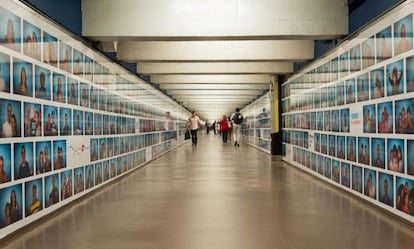Unknown author, uncharted impact
Collective artwork communities aim to unite society with the creative process

Art has no name, face or origin. Art is the people who imagine ideas and bring these creative manifestations into reality.
Perhaps this is why more and more creators of all disciplines are launching ideas in a collective form, a process that embraces openness, brings voices to the silenced and allows participation by professionals as well as the everyday citizen. Within these collective projects, any individual who wants to participate has the opportunity. Social networks define the central points of connection between the theorists who arrive at an idea for a project, the individuals who manage its production, and the spectators who wish to view the masterpiece. In the wake of the notorious economic crisis and savage budget cutbacks (especially in the arts), social networks provide an integral space in which to create synergistic energy and celebrate knowledge sharing within a community; it boosts the creative process, without restrictive certificates of authenticity.
The art made, however, is not only a product; it involves an idea, a process and tools. To make music, for example, you need instruments. The group Familiar's chosen role in this new wave of creativity is teaching others how to build synthesizers or modify electronic circuits for experimental sound purposes. "We are interested in the idea of do-it-yourself projects," explains Manuel Retamero. "And we share the conviction that institutions are monsters moving at exasperatingly slow speeds. Although the individual may be limited by financial means, he or she is also free of imposed limitations."
Retamero's non-profit uses the organization's income to provide materials and cover the expenses necessary for the workshops to take place. "Our users are often musicians," he explains, "but also art students, who use the tools to create interactive installations."
Institutions are slow-moving beasts; individuals have no restraints"
And it is in this kind of space that the barriers in contemporary creation fade into the distance. These avant-garde artists paint with music, write with colors and sculpt from drama. "Cooperation is our banner: we want to make communication barrier-free between disciplines. That is my obsession," admits Ernesto Caballero, director of Spain's National Drama Center (CDN) . His program Escritos en la escena (or, Written on the stage), launched last year, is the materialization of this longing: a program that creates opportunities for playwrights, directors and actors to work together. "After this synergistic work is done, it is presented to the audience, the final group to participate in the shared appreciation of the creative process." But the CDN initiative is merely a reflection of a deeper trend in theater. Companies like La Tristura are showing the play El Sur de Europa. Días de amor difíciles (or, Southern Europe. Difficult days for love) at la Cuarta Pared in Madrid. In this show, the four individuals involved work together in the manner of an assembly line.
"We've always run away from the idea of putting a name where it says director," says Violeta Gil, one of the four members. "Our roles have changed in the 10 years we've been together so that the group can survive... we're constantly reinventing."
Gil believes that a tendency toward changes in the traditional roles of theater managers has much to do with the current situation. "In the 1990s and early 2000s, which were boom years, people were plunged into the pool individually - but now we feel more alone. In this political and social context, we feel it is not worth it to have a single person in charge, because it's something that is failing."
Many minds in synchronous operation, according to Jairo Echeverri, "helps create things that make us grow." From this idea came his Cuento colectivo (or, Collective story), a project that is just one of many online writing platforms that exist on the internet.
An idea always grows when you share it. But it costs extra to live this way"
Beginning with a sentence, paragraph, or a finished story without a story, the users, amateur writers, decide how to proceed and where to put the final touch. Other initiatives in Spanish, like the Argentinean Literativa, open their platform to all formats - novels, poems, short stories - but do not define when the continuous feed, all a part of one story, should end. "All the authors write a story that will have a common starting point," says founder Miguel Braidot, "but different endings will branch out from this same starting point."
Another online art group formed in 2011 when five bloggers launched the collective project, La exposición expandida, which essentially made their blogs showrooms where spectators could view the individual projects of each blogger as a collective curatorial work. "At the same time that they proposed an alternative to the traditional exhibition format, they reaffirmed the importance of blogs in the art world," explains blogger Montaña Hurtado.
Without curatorial work, the Barcelona-based collective Wallpeople concentrates on the creativity of ordinary people in the making of murals. Once a year, the collective brings together artists from up to 30 countries, to gather in a specific area on a specific day to assemble photocollages based around a common theme chosen by volunteers. "An idea always grows when you share it," says founder Pablo Quijano. "But without the financial support, it costs extra to live this way."
Also lacking support is the group Cine sin Autor (Film without makers). Without funding, the organization cannot support filming outside of their studio-base in Madrid's Matadero cultural center. "There's a divide in the film industry and possibilities that are available right now," explains Gerardo Tudurí. "Many people have devices to produce audiovisual streams, and there are new social conditions and techniques that allow for a new type of film production."
Faced with two traditional roads - supporting film studies or focusing on traditional film writing - the group took another route: supporting the films made by regular citizens. These films, made individually or in groups, by the old or the young, by the experienced or the naïve, are all a part of the imaginative new collective.
"What we propose is a radical democratization of film," proposes Tudurí. "Art tends to moves in very elite circles, and introducing ordinary people generally comes with reluctance. But the truth is that within this common group, people are very willing to express themselves, and there is a world of unexpected film to discover."
Tu suscripción se está usando en otro dispositivo
¿Quieres añadir otro usuario a tu suscripción?
Si continúas leyendo en este dispositivo, no se podrá leer en el otro.
FlechaTu suscripción se está usando en otro dispositivo y solo puedes acceder a EL PAÍS desde un dispositivo a la vez.
Si quieres compartir tu cuenta, cambia tu suscripción a la modalidad Premium, así podrás añadir otro usuario. Cada uno accederá con su propia cuenta de email, lo que os permitirá personalizar vuestra experiencia en EL PAÍS.
¿Tienes una suscripción de empresa? Accede aquí para contratar más cuentas.
En el caso de no saber quién está usando tu cuenta, te recomendamos cambiar tu contraseña aquí.
Si decides continuar compartiendo tu cuenta, este mensaje se mostrará en tu dispositivo y en el de la otra persona que está usando tu cuenta de forma indefinida, afectando a tu experiencia de lectura. Puedes consultar aquí los términos y condiciones de la suscripción digital.
Últimas noticias
Maduro pleads not guilty before the federal court in New York: ‘I am still the president of Venezuela’
A new test can detect Alzheimer’s from a finger prick
UN team enters Sudanese city of El Fasher after paramilitary massacre: ‘It’s like a ghost town’
A recipe for resistance: Indigenous peoples politicize their struggles from the kitchen
Most viewed
- Gilles Lipovetsky: ‘If you want to live better and fall in love, take Prozac, don’t look to philosophy’
- Alain Aspect, Nobel laureate in physics: ‘Einstein was so smart that he would have had to recognize quantum entanglement’
- Alvin Hellerstein, a 92-year-old judge appointed by Bill Clinton, to preside over Maduro’s trial in New York
- Maduro’s downfall puts China’s relationship with Venezuela to the test
- Why oil has been at the center of Venezuela-US conflicts for decades









































